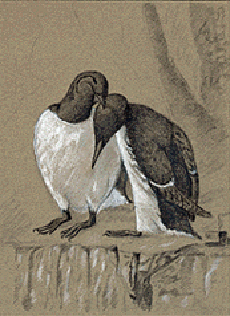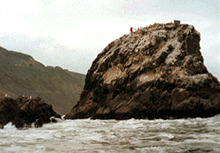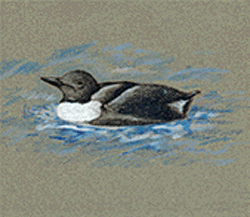|

MURRES are
... sensitive. The 20th century has been rough on them, and even the
19th century ended badly. The murres' biggest, bustlingest breeding
colony is on the Farallone Islands, just north of San Francisco. As
many as six million murres nested there in the early 1800s. In the late
1850s, however, the Farallone Egg Company started harvesting murre eggs.
The chicken population couldn't keep up with the burgeoning human population
of California, so the murre eggs were gathered to meet the demand. Since
the birds do not breed until they are four to six years old, and since
each pair produces just one egg per season, egging quickly threatened
the colony. The egg company battled over land rights with the federal
government, which claimed the Farallones as lighthouse territory. Federal
marshals hauled the eggers off the island in 1896.
Left alone with the lighthouse keeper and a few other
human companions, the murres began to mate their way back to a recovering
population. Growing technological progress begat pollution, however,
when oil tankers started plying the coastal waters between southern
California and San Francisco Bay. The ships regularly flushed their
tanks at sea, trailing miles-long oil slicks where murres bobbed in
the waves.
Marine birds unlucky enough to be coated with oil
meet with a shop-of-horrors variety of gruesome ends. Birds that inhale
or swallow toxins from freshly spilled oil suffer pneumonia and kidney
and liver damage. Oil on an eggshell poisons the developing embryo inside.
Floating oil coats birds' feathers, ruining their insulating effects
and weighing the birds down. The birds die from drowning, hypothermia
and exhaustion.
In the 1920s, after documenting oil's threat to marine
birds, environmental groups, including the Audubon Society, and the
U.S. Biological Survey worked with oil companies to build on-shore tanks
to store waste oil. Since then, ever-stricter environmental laws have
protected marine life from most intentional oil pollution. Nevertheless,
accidental spills threaten wildlife each year.
Gill nets, the murre's latest foe, snag and drown
murres and other diving birds. The wide nets, dragged behind boats,
gained popularity in the 1970s, but federal, state and regional restrictions
now force gill net fishers far off shore. The past decade has been relatively
peaceful for the murres, and their numbers have increased to 50,000-100,000
at the Farallone breeding site.
The mock murre colony at Devil's Slide Rock, populated
by decoys and serenaded by stereo equipment, mimics a real colony so
well that several live, randy murres have decided to join the crowd.
A few murres settled down at the colony during the project's first year,
and some laid eggs. Last year, the third year of the repopulation effort,
nine breeding pairs made Devil's Slide Rock their home, and 30 other
non-breeding birds hung out at the colony. Some of the murres, who can
live more than 20 years, were probably members of the original colony
wiped out by the oil spill. Seeing their native breeding grounds once
again teeming with life, they may have decided to give Devil's Slide
Rock one more chance. Last year's breeders will almost certainly be
back this year, since murres return loyally (even romantically) to sites
where they have bred successfully.
 AFTER
SETTING out the first flock of decoys two weeks ago, some of the biologists
returned to see what kind of response their faux-murres would elicit.
With muscles still aching from the previous day's climb, they trained
their binoculars on Devil's Slide Rock from the highway and counted
30 murres. AFTER
SETTING out the first flock of decoys two weeks ago, some of the biologists
returned to see what kind of response their faux-murres would elicit.
With muscles still aching from the previous day's climb, they trained
their binoculars on Devil's Slide Rock from the highway and counted
30 murres.
"This feels like a colony," says Carter, who has studied
murres for 20 years. Murres fly around the cove and swim near Devil's
Slide Rock. The birds are waiting for the biologists to leave so they
can have a little privacy. As the biologists hover over their wooden
chicks and eggs, a California gray whale surfaces 30 feet from the rubber
boat. "Holy mackerel!" yells Carter, spinning the Zodiac around for
a better look.
San Pedro Rock, where murres last nested 90 years
ago, frames the other end of the cove. The murre biologists decided
that since the Devil's Slide Rock colony is attracting murres so successfully,
they should try to repopulate San Pedro Rock as well. Once the rock
climbers have nestled the last decoy chicks and eggs into place on Devil's
Slide Rock, Carter picks them up and ferries them across the cove.
Boyce leaps into the Zodiac laughing. She says that
she still loves the work, even after three seasons of climbing around
on the guano-frosted rock. "Maybe after the fourth season I'll get tired
of it," she says over the growl of the outboard engine.
They haul more supplies in from the patiently watching
Queen of Hearts. Carter darts the Zodiac up to San Pedro Rock in between
crashing waves, and Nothhelfer heaves solar panels, decoys, and 50-pound
batteries up to Parker, balanced precariously on the rocks. After all
of the supplies and scientists have been delivered, they painstakingly
ascend San Pedro Rock and place decoys all around. They anchor the mirrors
and position the loudspeakers, preparing to cast another spell.
Murre populations have plummeted in many of their
historic nesting areas, but the birds are wide-ranging. In the Pacific
Ocean, they breed from Big Sur up to Alaska and along the Asian coast
down to Japan. In the Atlantic, they nest from Maine up through Canada
and down through Scandinavia, Britain, France and Portugal. Throughout
the range, oil pollution and gill netting have killed the birds or forced
them from their historic breeding grounds. Devil's Slide Rock and San
Pedro Rock are close enough to an surviving colony, the one in the Farallone
Islands, that murres find the decoy colonies and may be persuaded to
homestead there.
 Carter
doesn't envy the biologists trying to help the California condor recover.
In 1987, when the last birds were captured and introduced into a captive
breeding program, only 27 condors were alive. "That's why we want to
do this now," says Carter of the murre restoration project. "We want
to bring them back before it's too late, while we can still make a difference." Carter
doesn't envy the biologists trying to help the California condor recover.
In 1987, when the last birds were captured and introduced into a captive
breeding program, only 27 condors were alive. "That's why we want to
do this now," says Carter of the murre restoration project. "We want
to bring them back before it's too late, while we can still make a difference."
<<
previous
|


 AFTER
SETTING out the first flock of decoys two weeks ago, some of the biologists
returned to see what kind of response their faux-murres would elicit.
With muscles still aching from the previous day's climb, they trained
their binoculars on Devil's Slide Rock from the highway and counted
30 murres.
AFTER
SETTING out the first flock of decoys two weeks ago, some of the biologists
returned to see what kind of response their faux-murres would elicit.
With muscles still aching from the previous day's climb, they trained
their binoculars on Devil's Slide Rock from the highway and counted
30 murres.  Carter
doesn't envy the biologists trying to help the California condor recover.
In 1987, when the last birds were captured and introduced into a captive
breeding program, only 27 condors were alive. "That's why we want to
do this now," says Carter of the murre restoration project. "We want
to bring them back before it's too late, while we can still make a difference."
Carter
doesn't envy the biologists trying to help the California condor recover.
In 1987, when the last birds were captured and introduced into a captive
breeding program, only 27 condors were alive. "That's why we want to
do this now," says Carter of the murre restoration project. "We want
to bring them back before it's too late, while we can still make a difference."